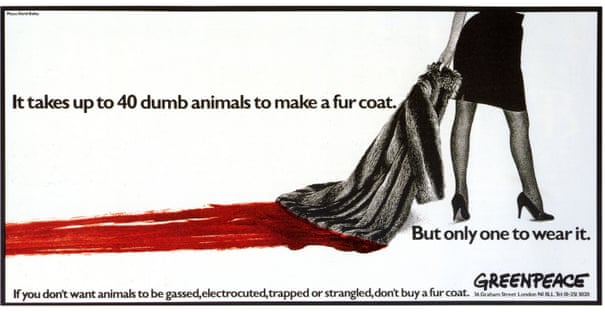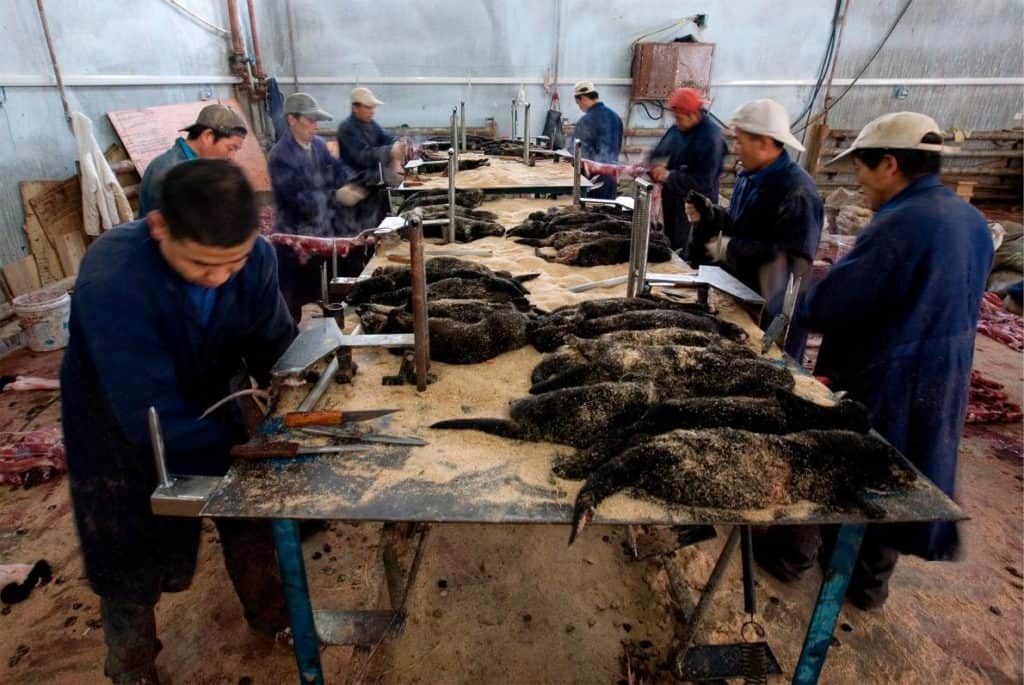When I campaigned for animal rights as a teenager in the 1980s, anti-fur campaigners produced an iconic poster. Alongside an image of a smartly dressed woman holding a bloody fur coat was a cracker of a slogan: “It takes up to 40 dumb animals to make a fur coat. But only one to wear it.”
Even as an angry teen I could see the complexity of some animal rights issues. Vivisection was sometimes used to save human lives. Nutrients can be gained by eating meat. But fur? Fur seemed a no-brainer. Why should animals die to produce a ridiculous-looking coat? If you’d have told me back then that we’d still be discussing this three decades on, I wouldn’t have believed you. Surely the industry would have been eradicated?
Progress has been made – fur farms were banned in the UK in 2003, and selling cat, dog and seal products is also illegal. But imported fur from other species, including fox, rabbit, mink, coyote, raccoon dog and chinchilla, is still allowed. And this week an investigation by Sky News found that supposedly “fake fur” products, including gloves, hats and shoes, at leading retailers actually contain real fur from cats, raccoon dogs, rabbits, mink and fox.
This discovery has upset shoppers who thought the fur they were buying was synthetic. Never mind the labels, they assumed the cheap price tags alone meant the fur couldn’t be real. The shopper who sparked the investigation when she realised that the “faux fur” pom-poms on her pink stilettos were actually made from cat hair said the discovery was “really hurtful, really shocking”, because her “life is basically animals”.
But why would anyone who cares about animals want to wear fake fur? True, its fluffiness can have a certain sensual appeal, but the cruelty involved in producing the real thing is such a horrifying business, I wonder why an animal lover would want to be associated with it. Why connect yourself, even symbolically, to such barbarity?

Commercial fur often comes from China, where it’s produced very cheaply, frequently due to ghastly conditions. The animals, who spend their whole lives in wire cages, often succumb to anxiety-induced psychosis, gnawing away at their own limbs and hurling themselves repeatedly against the cage bars.
It’s a horrific life all the way to the end. The animals are finally grabbed from their cages and bludgeoned or strangled to death – if they’re lucky. Undercover investigators from Swiss Animal Protection/EAST International found that in many cases the more unfortunate ones were still alive as they were being skinned.
Even after the skinning, when their hairless, bloodied bodies were tossed onto a pile, some were still alive, gasping for air and blinking. In a harrowing video, one skinned raccoon dog found the strength to lift his bloodied head and stare into the camera, as if to ask us why we have done this to him.
But it’s not just in China that horrors occur. An undercover investigation into a farm in the United States produced a video nasty of its own. Animals bred for their fur there often spend their entire lives in cages too, before being slaughtered by gassing, neck-breaking, or electrocution of the genitals.

It’s time we consigned this peculiar trend to the history books, allowing future generations to read with disgust and bewilderment at how badly their predecessors treated animals. There are precedents: in March Berkeley became the second city in California to ban the sale of any fur clothing, following in the footsteps of West Hollywood, which outlawed it in 2013.
But what about the fake stuff? Banning fake fur would seem an over-reaction (though it would certainly avoid any future confusion for well-meaning shoppers). More sensible than a ban might be a boycott. Wearing fake fur endorses a place for fur of any kind in the fashion industry, and given that we now know some “fake” fur is in fact real, and the product of great suffering, the vain hope that it could be separated from that cruelty in our minds has probably been extinguished.

So leave fur, real or imagined, on the shelf and build your look on something other than animal cruelty. There’s nothing beautiful about pretending to be wearing an abused animal.
This article was first published by The Guardian on 12 Apr 2017. Lead Image: A mink looks out of its open cage on a farm in China. Fur farmers there face few regulations, and there are no animal welfare laws to protect the animals. Photograph by Diego Azubel, EPA/Redux.
We invite you to share your opinion whether there should be a worldwide ban on fur farming? Please vote and leave your comments at the bottom of this page.
Thank you for voting.
Editorial Comment: The purpose of this poll is to highlight important wildlife conservation issues and to encourage discussion on ways to stop wildlife crime. By leaving a comment and sharing this post you can help to raise awareness. Thank you for your support.







Leave a Reply